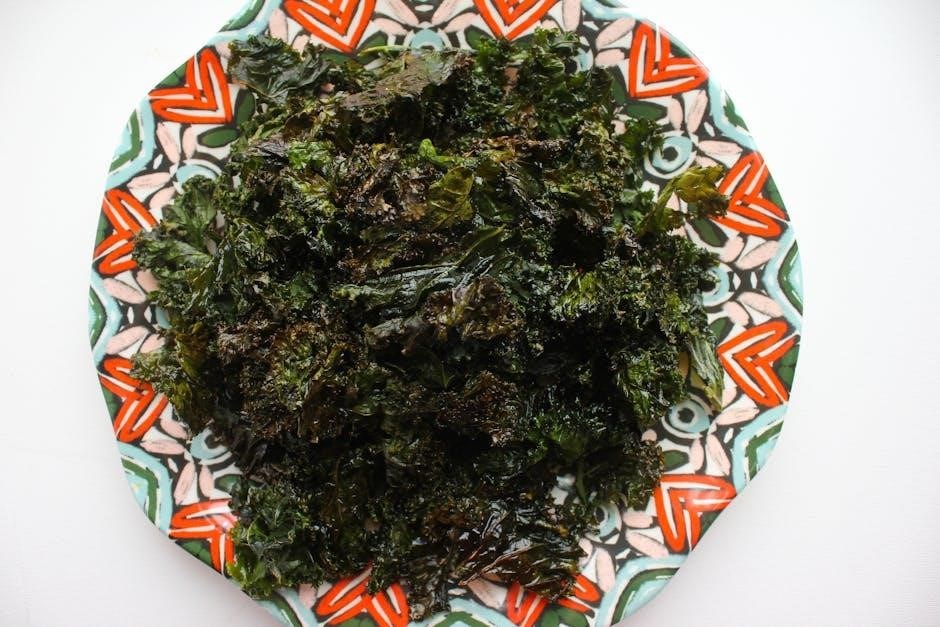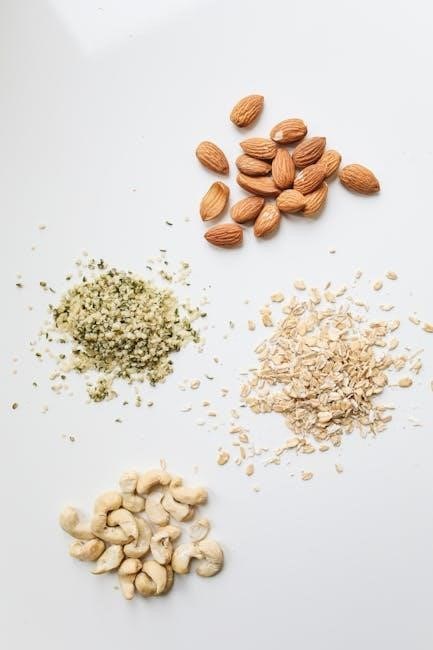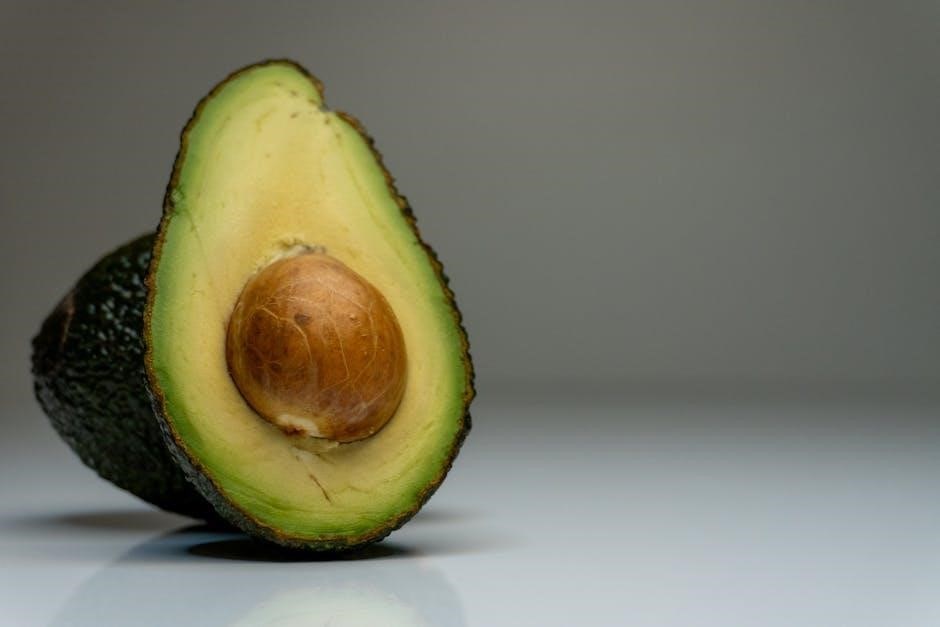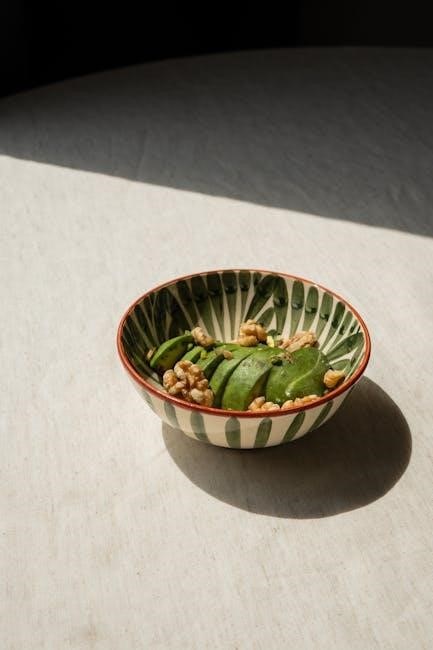
A low-fat diet focuses on reducing fat intake to promote health and weight management, emphasizing lean proteins, whole grains, fruits, and vegetables while minimizing processed and high-fat foods.
1.1 What is a Low-Fat Diet?
A low-fat diet emphasizes reducing fat intake, focusing on lean proteins, whole grains, and a variety of fruits and vegetables. It limits saturated and unsaturated fats, typically recommending no more than 20-35% of daily calories from fat, promoting healthier eating habits and weight management while maintaining essential nutrients.
1.2 Benefits of a Low-Fat Diet
A low-fat diet reduces saturated fat intake, improving heart health and lowering cholesterol levels. It aids in weight management by focusing on nutrient-dense foods, promoting a balanced intake of essential vitamins and minerals while minimizing empty calories from high-fat foods.

Understanding Food Groups in a Low-Fat Diet
A low-fat diet emphasizes whole, nutrient-rich foods, including lean proteins, whole grains, fruits, vegetables, and low-fat dairy, while reducing intake of processed and high-fat items.
2.1 Dairy Products for a Low-Fat Diet
In a low-fat diet, choose skim milk, evaporated skim milk, and nonfat yogurt or sour cream. These options are rich in calcium and protein while minimizing fat intake. Avoid whole milk, cheese, and buttermilk to keep dairy consumption low in saturated fats and calories.
2.2 Protein Sources: Lean Meats and Fish
Opt for lean meats like skinless chicken, turkey, and lean cuts of beef or pork. Fish, such as cod, tilapia, and salmon, are excellent choices. Prepare by grilling, baking, or steaming without added fats. Aim for 3-ounce portions to maintain a balanced intake without excessive fat. Avoid processed meats and high-fat sauces or seasonings to keep your diet low in fat.
2.3 Whole Grains and Fiber-Rich Foods
Incorporate whole grains like brown rice, quinoa, oats, and whole-grain breads into your diet. Fiber-rich foods such as barley, rye, and buckwheat provide essential nutrients. Include legumes like lentils, chickpeas, and black beans for their high fiber and protein content. These foods are naturally low in fat and support digestive health, making them ideal for a low-fat diet;
2.4 Fruits and Vegetables: Naturally Low in Fat
Fruits and vegetables are excellent choices for a low-fat diet, as they are naturally low in fat and rich in vitamins, minerals, and fiber. Include a variety such as berries, citrus fruits, leafy greens, and cruciferous vegetables like broccoli and spinach. These foods support overall health, aid in digestion, and contribute to a balanced, low-fat diet.

Preparing a Low-Fat Grocery List
Include lean proteins, whole grains, fruits, and vegetables. Opt for skim milk, egg whites, and herbs for flavor. Avoid high-fat ingredients and processed snacks; Always read nutrition labels to ensure low fat content.
3.1 Essential Items for Your Pantry
Stock whole grains like brown rice, oats, and quinoa. Include canned beans, lentils, and low-sodium vegetables. Herbs, spices, and flavorings like garlic, paprika, and turmeric add taste without fat. Store low-fat snacks such as whole-grain crackers, nuts in moderation, and seeds. Always check expiration dates and nutrition labels to ensure items align with your low-fat goals.
3.2 How to Read Nutrition Labels for Fat Content
Check the Nutrition Facts Table for total fat grams and percentage of the Daily Value (DV). Look for labels indicating “low-fat” or “reduced fat.” Be aware of serving sizes, as they can be misleading. Avoid products with added fats like butter or oil. Choose items with less than 10 grams of fat per serving to stay on track with your low-fat diet goals.

Low-Fat Cooking Methods
Low-fat cooking involves grilling, baking, steaming, or stir-frying to avoid added fats. Use herbs and spices for flavor, and opt for non-stick pans to reduce oil needs.
4.1 Healthy Cooking Techniques
Healthy cooking techniques for a low-fat diet include grilling, baking, steaming, roasting, and stir-frying. These methods avoid added fats while preserving nutrients. Use herbs and spices to enhance flavor without relying on oil or butter. Non-stick cookware can reduce the need for extra fat, making meals healthier and more flavorful. These techniques help maintain a balanced and low-fat diet effectively.
4.2 herbs and Spices for Flavor Without Fat
4.2 Herbs and Spices for Flavor Without Fat
Herbs and spices add rich flavor to meals without adding fat. Common choices include basil, oregano, cumin, paprika, and chili powder. These seasonings enhance taste naturally, allowing you to enjoy delicious meals while adhering to a low-fat diet. They also provide antioxidants and health benefits, making them a great alternative to oil-based flavorings in your recipes and dishes.

Snacks and Sweets in a Low-Fat Diet
Incorporate healthy snacks like fruits, nuts, and low-fat yogurt. Opt for sweet treats such as gelatin, sorbet, or fruit-based desserts to satisfy cravings without excess fat intake.
5.1 Healthy Snacking Options
Choose snacks like fresh fruits, baby carrots, and air-popped popcorn. Low-fat yogurt, whole grain crackers, and nuts in moderation are also great options. Avoid fried or processed snacks high in saturated fats. Opt for fruit-based snacks, such as fruit whips or sorbet, to satisfy sweet cravings without adding excess fat. These choices support a balanced low-fat diet.
5.2 Low-Fat Sweet Treats
Indulge in low-fat sweet treats like sorbet, fruit whips, or sherbet. Opt for low-fat frozen desserts or puddings made with skim milk. Angel food cake and ginger snaps are excellent choices. These options satisfy sweet cravings while keeping fat content minimal, making them ideal for a low-fat diet without compromising on flavor or enjoyment.

Managing Portion Sizes
Tracking food portions helps maintain healthy fat intake. Plan meals ahead and use a food record to monitor consumption, ensuring balanced nutrition without overeating.
6.1 Understanding Serving Sizes
Understanding serving sizes is crucial for managing fat intake. Check nutrition labels for specific portion sizes and calorie content. Plan meals to avoid overconsumption by measuring accurately, ensuring you stay within daily fat limits. This helps maintain a balanced diet and prevents excessive fat intake without sacrificing nutritional value or flavor.
6.2 Avoiding Overconsumption of Fat
Avoiding overconsumption of fat requires mindful eating and strategic food choices. Limit fried foods, high-fat snacks, and processed items. Opt for baking, grilling, or steaming instead of frying. Be cautious of hidden fats in sauces and dressings. Moderation is key, even with healthier fats, to maintain overall balance and adhere to dietary goals effectively.

Foods to Avoid on a Low-Fat Diet
High-fat foods like fried items, processed snacks, and fatty meats should be limited. Avoid foods with added oils, butter, and cream to reduce overall fat intake effectively.
7.1 High-Fat Foods to Limit
High-fat foods such as fried items, processed snacks, fatty meats, and full-fat dairy products should be limited. These foods are typically high in saturated fats, which can increase cholesterol levels and contribute to weight gain. Reducing their consumption helps maintain a balanced diet and supports overall health goals effectively.
7.2 Hidden Sources of Fat in Foods
Certain foods, like baked goods, processed snacks, and sauces, often contain hidden fats. Ingredients such as butter, oil, and nuts can significantly increase fat content. Reading nutrition labels helps identify these sources and make informed choices to maintain a low-fat diet effectively without compromising on flavor or nutrition.

Benefits of a Low-Fat Diet
A low-fat diet supports heart health, aids in weight management, and reduces the risk of chronic diseases like diabetes and certain cancers by limiting unhealthy fat intake.
8.1 Health Advantages
A low-fat diet offers numerous health benefits, including improved heart health by reducing cholesterol levels, lowering blood pressure, and minimizing the risk of cardiovascular diseases. It also aids in managing blood sugar levels, which is beneficial for diabetes control. Additionally, it supports a healthier weight, reducing the risk of obesity-related conditions and promoting overall well-being by focusing on nutrient-rich foods.
8.2 Weight Management
A low-fat diet is an effective strategy for weight management, as it reduces calorie intake while emphasizing nutrient-dense foods like lean proteins, whole grains, fruits, and vegetables. By minimizing high-calorie fats, it supports sustainable weight loss and helps maintain a healthy weight, promoting a balanced metabolism and reducing hunger between meals for better overall control.

Common Mistakes to Avoid
Common mistakes include neglecting to read nutrition labels, overconsumption of processed foods, and ignoring hidden fats in seemingly healthy options like sauces or snacks.
- Avoid assuming “low-fat” means “guilt-free.”
- Be cautious of portion sizes.
- Don’t overlook hidden fats in condiments and dressings.
9.1 Pitfalls in Low-Fat Eating
Common pitfalls include relying on processed “low-fat” foods, neglecting portion control, and over-consuming hidden fats in sauces or dressings. Many low-fat products are high in sugar or sodium, which can hinder weight loss and health goals. Additionally, some dieters may mistakenly believe that all fats are harmful, leading to an imbalanced diet lacking essential fatty acids.
9.2 Maintaining Nutritional Balance
Maintaining balance involves ensuring adequate intake of essential nutrients like omega-3 fatty acids, vitamins, and minerals. Incorporating whole foods, lean proteins, and healthy fats, such as avocados and nuts, supports overall health without excessive fat consumption. Consulting a nutritionist or using a meal plan can help avoid deficiencies and ensure a well-rounded low-fat diet.
A low-fat diet promotes health and weight management by focusing on nutrient-rich foods like fruits, vegetables, and lean proteins, while reducing processed and high-fat items for long-term benefits.
10.1 Summary of Key Points
A low-fat diet involves making informed food choices to reduce fat intake while maintaining nutritional balance. Focus on lean proteins, whole grains, fruits, vegetables, and low-fat dairy. Avoid high-fat, fried, and processed foods. Plan meals, read nutrition labels, and use herbs and spices for flavor. This approach supports heart health, weight management, and overall well-being, making it a sustainable lifestyle choice.
10.2 Encouragement for a Successful Low-Fat Diet
Embrace a low-fat diet by planning meals, exploring new recipes, and incorporating fresh, nutrient-rich foods. Celebrate small victories and stay consistent. Remember, it’s a journey toward better health and long-term well-being. With dedication and mindful choices, you can achieve your goals and enjoy a balanced, flavorful diet that nourishes your body and soul.